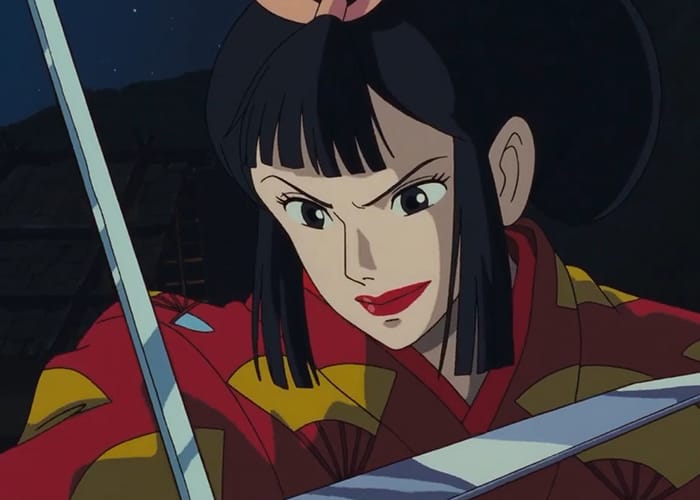This article is part of our Villains Week series.
Hayao Miyazaki is known for his complex female protagonists, from Chihiro in Spirited Away to Nausicaa in Nausicaa of the Valley of the Wind. They are all young women who experience trials and tribulations to save the world and grow as people. No matter their age, these girls are powerful and capable of anything. But while Miyazaki’s heroes are well-loved and showered with praise, there is another female character in his oeuvre that deserves recognition: Lady Eboshi, the villain of Princess Mononoke.
Prince Ashitaka of the reclusive Emishi people fights and kills a cursed boar covered in strange purple worm-like protrusions that seem to have minds of their own. But he does not escape the fight unscathed, as the tendrils wrap around Ashitaka’s wrist and spread the curse. As the boar’s body melts away, the source of such a horrific affliction is revealed to be a ball of iron — a crudely made bullet — lodged in his gut. Ashitaka is sent out of his village to find out where the bullet came from and how to stop whoever is making them. He finally arrives in Irontown, the origin of the bullet and home of Lady Eboshi.
Amidst a land full of feudal rivalries and samurai violence, Eboshi built Irontown deep in the forest. It is a fortress surrounded by high walls and a large lake to protect its people from attack. Here, Eboshi leads an effort to build an early version of the rifle. She is an industrialist, focusing on the power of iron and the forge to create a powerful weapon that can tear through flesh from a distance. But it is not just human flesh she wishes to destroy; it is also the flesh of the gods of the woods, such as giant wolves and the massive Forest Spirit.
Irontown has rendered its surrounding landscape barren as townspeople cut down trees to fuel the forge’s flames. To Eboshi, human progress trumps protecting the environment. She doesn’t care that the ape spirits no longer have homes. Her ultimate goal is self-preservation in the form of decapitating the Forest Spirit: delivering its head to the Emperor will grant him immortality, and she will be granted protection from warring samurai lords. She pays no mind to the consequences of killing such a deity. Her own survival is all that matters.
While her intentions are selfish and she seems to act only to save herself, Eboshi also helps those whom she believes need it most. While the men of the town go out with livestock, the women, who are former sex workers, work the forges in shifts that keep the fires of Irontown ablaze. In a secret garden, Eboshi also houses a colony of lepers who construct her guns. She has taken in the misfits and given them a chance when no one else would.
Eboshi works hard to empower the women of Irontown to achieve independence, even within their marriages. These women are shown standing up to their husbands and soldiers while also working at the forge and wielding weapons when the town is under attack. In the era of Japan in which this film is set — the 14th century — this is a rare sight. Some of the older villagers comment on how the women are too outspoken, saying that Lady Eboshi has given them too much freedom. But that is her goal. These women, who were seen as outcasts for selling sex, deserve better treatment. Eboshi provides that as well as important roles within the community to make them integral to Irontown’s success.
The colony of lepers also serves an important purpose for Irontown by designing, producing, and testing Eboshi’s rifles. They enjoy a life of acceptance, care, and peace. One leper, Osa, explicitly explains how she is the first person to treat them as human beings and wash their rotting flesh; she was the first person to show them any sort of kindness. However, they are not integrated into the community and are still kept hidden away. Eboshi seems to know that while the villagers can understand empowered women, they would not be so accepting of those with an infectious disease.
These women and lepers live what are assumed to be much better lives in Irontown, but they must exchange their labor for protection. Eboshi is housing, feeding, and employing them, yes, but it could be seen as a cheaper labor force, one that will be more willing to work more hours for less pay. That type of exploitation is never really explored; rather, Eboshi is seen as a gracious and generous leader.
While Lady Eboshi is the villain of Princess Mononoke, Miyazaki does not make her as evil as his other bad guys, seen in films such as Castle In The Sky and Nausicaa. She exists in a strange gray area where, yes, her actions are easily labeled as bad, but her intentions can be perceived as good. Her focus is not on the environment but on what she sees as the betterment of humankind; nature is nothing more than another enemy that must be conquered in the name of progress. While her philanthropic desire to help sex workers and “her” lepers may seem self-serving and a way to justify her destruction of the landscape, there is no denying the resources and care she shows those who are deemed unwanted by society.
To Lady Eboshi, Irontown is a utopia, where women are just a powerful as men, where lepers are not looked upon in disgust, and where a woman can lead an entire army. She is an idealistic villain, whose blindness to the consequences of her actions have devastating effects on the world around her.

